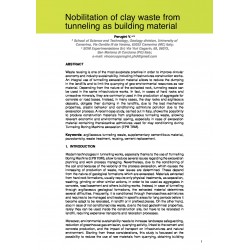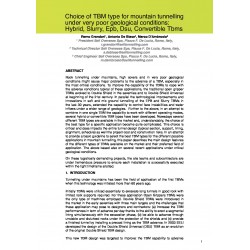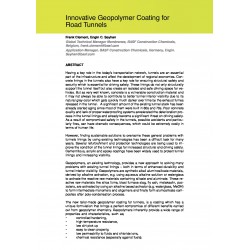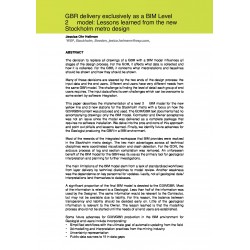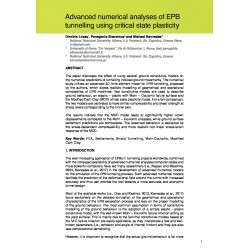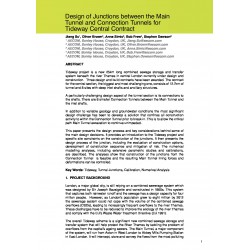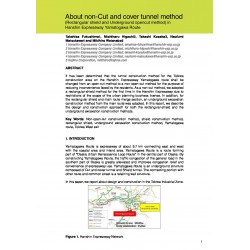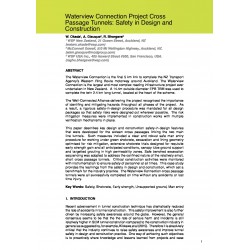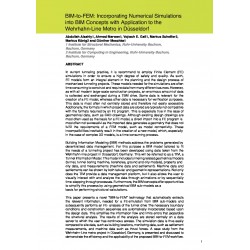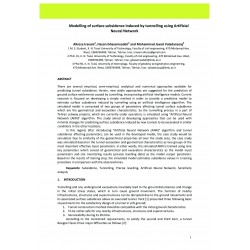No document
Search & filter
Search for a publication
Search & filter
World Tunnelling Congress
WTCThere are 1984 documents.
-
Nobilitation of clay waste from tunneling as building material
Abstract: Waste reusing is one of the most auspicate practice in order to improve circular economy and industry sustainability, including infrastructures construction works. An integral use of tunnelling excavation material allows to reduce the dumping in the landfills and to limit the quarrying of geo-environmental resources as raw material. Depending from the nature of the extracted rock, tunneling...
0,00 € -
Choice of TBM type for mountain tunnelling under very poor geological conditions: Hybrid, Slurry, Epb, Dsu,...
Abstract: Rock tunnelling under mountains, high covers and in very poor geological conditions might cause major problems to the advance of a TBM, especially in the most critical conditions. To improve the capability of the TBMs to cope with the adverse conditions typical of these applications, the traditional open gripper TBMs evolved to Double Shield in the seventies and to Double Shield Universal at...
0,00 € -
Experimental evaluation of soil-foam mixing under pressure
Abstract: EPB TBM tunneling often relies upon the assumption of homogeneous conditioned soil in the tool gap of the cutterhead. Such a conditioned soil zone ensures that impermeability is maintained, that torque is lowered, and that the pressure from excavation chamber equilibrates in the tool gap, minimizing force on the cutterhead. Foam injection at the cutterhead occurs through a discrete number of...
0,00 € -
Consultant’s view of durable and sustainable concrete tunnel constructions in the Middle East)
Abstract: This paper presents the latest developments in concrete technology achieved on recent tunnel projects in the Middle East region. Strenuous requirements have been defined on recent underground concreting works in terms of strength, durability, workability and associated construction cost. COWI’s concrete technology and design teams worked closely with international contractors to implement the...
0,00 € -
Innovative Geopolymer Coating for Road Tunnels
Abstract: Having a key role in the today’s transportation network, tunnels are an essential part of the infrastructure and affect the development of regional economies. Concrete linings in the tunnels also have a key role for ensuring structural safety and security which is essential for driving safety. These linings do not only structurally support the tunnel itself but also create an isolated and safe...
0,00 € -
GBR delivery exclusively as a BIM Level 2 ½ model: Lessons learned from the new Stockholm metro design
Abstract: The decision to replace all drawings of a GBR with a BIM model influences all stages of the design process. For the GDR, it affects what data is collected and how it is collected. For the GBR, it concerns what interpretations and baselines should be shown and how they should be shown. Many of these decisions are steered by the two ends of the design process: the input data and the end users....
0,00 € -
Advanced numerical analyses of EPB tunnelling using critical state plasticity
Abstract: The paper discusses the effect of using several ground constitutive models on the numerical predictions of tunnelling induced ground movements. The numerical study utilizes an advanced 3D finite element model for EPB tunnelling, proposed by the authors, which allows realistic modelling of geometrical and operational complexities of EPB machines. Two constitutive models are used to describe...
0,00 € -
Reinforced Concrete Tunnel Junctions: Design and Construction Guidelines
Abstract: Whilst junctions between a tunnel and another tunnel, shaft, or other underground structure typically account for only a small proportion of the total length of a tunnelling project, their design and construction invariably present significant challenges. These challenges manifest themselves during the excavation and the installation of both the initial and permanent support. While many...
0,00 € -
Numerical analyses for the design of fiber reinforced precast concrete lining segments for ram thrust forces
Abstract: Fibre reinforcement is increasingly used in civil works to improve materials strength against brittle failure mode. In mechanized tunnelling, precast concrete lining design and reinforcement dimensioning is carried out according to various loading schemes covering to the entire service life of segments and rings. One of the most onerous load conditions is related to the longitudinal ram forces...
0,00 € -
Design Aspects of Fibre Reinforced Shotcrete Linings based on Experimental Test Results
Abstract: The design of fbre reinforced shotcrete (FRS) linings for tunnels or mines is commonly based on the well-known and widely recognised Q-System or Barton charts. This performance based design approach accesses the results of experimental tests, carried out on panel specimens according to existing standards or guidelines. This is different to the general methodology to access and determine the...
0,00 € -
Design of Junctions between the Main Tunnel and Connection Tunnels for Tideway Central Contract
Abstract: Tideway project is a new 25km long combined sewage storage and transfer system beneath the river Thames in central London currently under design and construction. Three design and build contracts have been awarded. The contract for the central section, the biggest and most challenging one, consists of 12.7km of tunnel and 8 sites with deep inlet shafts and ancillary structures.A particularly...
0,00 € -
About non-Cut and cover tunnel method (Rectangular shield and Underground opencut method) in Hanshin Expressway...
Abstract: It has been determined that the tunnel construction method for the Tokiwa construction area on the Hanshin Expressway Yamatogawa route shall be changed from an open-cut method to a non-open-cut method for the purpose of reducing inconvenience faced by the residents. As a non-cut method, we adopted a rectangular-shield method for the first time in the Hanshin Expressway due to restrictions of...
0,00 € -
Waterview Connection Project Cross Passage Tunnels: Safety in Design and Construction
Abstract: The Waterview Connection is the final 5 km link to complete the NZ Transport Agency’s Western Ring Route motorway around Auckland. The Waterview Connection is the largest and most complex roading infrastructure project ever undertaken in New Zealand. A 14.4m outside diameter EPB TBM was used to complete the twin 2.4 km long tunnel, located at the heart of the scheme. The Well-Connected Alliance...
0,00 € -
BIM-to-FEM: Incorporating Numerical Simulations into BIM Concepts with Application to the Wehrhahn-Line Metro in...
Abstract: In current tunneling practice, it is recommend to employ Finite Element (FE) simulations in order to ensure a high degree of safety and quality. As such, FE models form an integral element in the planning and the design process of mechanized tunneling projects. These models needed for the simulations are oftentime consuming to construct and require data from many different sources. However,as...
0,00 € -
Excess pore water pressures in front of a tunnel face when drilling in a semiconfined aquifer
Abstract: When drilling with a TBM (Tunnel Boring Machine) in saturated sand, excess pore water pressures occur in the sand in front of the TBM. The magnitude of these excess pore water pressures depends on the permeability of the sand, the drilling velocity, the layering of the soil. These excess pore water pressures will decrease the stability of the tunnel face and influence the plastering of that...
0,00 € -
Modelling of surface subsidence induced by tunnelling using Artificial Neural Network
Abstract: There are several empirical, semi-empirical, analytical and numerical approaches available for predicting tunnel subsidence. Herein, new viable approaches are suggested for the prediction of ground surface settlements caused by tunnelling, incorporating artificial intelligence models. Current research is focused on developing a simple method in order to provide...
0,00 €

